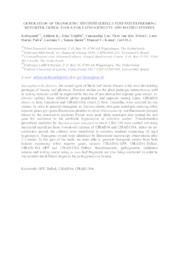Generation of transgenic Mycosphaerella fijiensis expressing reporter genes: tools for pathogenicity and mating studies.
Generation of transgenic Mycosphaerella fijiensis expressing reporter genes: tools for pathogenicity and mating studies.
Author(s): KOBAYASHI, A. K.; DIAZ TRUJILLO, C.; LEE, T. van der; ZWIERS, L.-H.; PAIVA, L. V.; SOUZA JUNIOR, M. T.; KEMA, G. H. J.
Summary: Mycosphaerella fijiensis, the causal agent of black leaf streak disease is the most devastating pathogen of banana and plantains. Detailed studies on the plant pathogen interaction as well as mating behavior could be improved by the use of non-destructive reporter gene assays. M. fijiensis isolates from different global populations and opposite mating types, CIRAD86 (Mat1-1) from Cameroon and CIRAD139A (Mat1-2) from Colombia, were selected for our studies. In order to generate transgenic M. fijiensis strains, two gene constructs carrying either reporter genes gfp (green fluorescent protein) or dsred (Discosoma sp. red fluorescent protein) driven by the constitutive promoter PtoxA were used. Both constructs also carried the hph gene for resistance to the antibiotic hygromycin as selective marker. Transformation procedures mediated by Agrobacterium tumefaciens strain LBA1100 were carried out using macerated mycelium from 3-week-old cultures of CIRAD86 and CIRAD139A. After the cocultivation period, the cultures were transferred to selective medium containing 30 mg/l hygromycin. Transgenic events were identified by fluorescent microscopy observations after 2-3 weeks. In this part of the work, we were able to generate transgenic strains from both isolates expressing either reporter genes, namely CIRAD86::GFP, CIRAD86::DsRed, CIRAD139A::GFP and CIRAD139A::DsRed. Simultaneously, pathogenicity validation screens and mating assays using in vitro leaf fragments are also being conducted in order to characterize the different stages in the pathogenesis on banana.
Publication year: 2008
Types of publication: Abstract in annals or event proceedings
Unit: Embrapa Mid-North
Observation
Some of Embrapa's publications are published as ePub files. To read them, use or download one of the following free software options to your computer or mobile device. Android: Google Play Books; IOS: iBooks; Windows and Linux: Calibre.
Access other publications
Access the Agricultural Research Database (BDPA) to consult Embrapa's full library collection and records.
Visit Embrapa Bookstore to purchase books and other publications sold by Embrapa.

